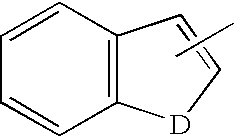Linear basic compounds having NK-2 antagonist activity and formulations thereof
a technology of nk-2 and basic compounds, which is applied in the field of tachykinin compound antagonists, to achieve the effect of better in vivo antagonist activity and better inhibition of bonding behaviour
- Summary
- Abstract
- Description
- Claims
- Application Information
AI Technical Summary
Benefits of technology
Problems solved by technology
Method used
Image
Examples
example 1
Nα[Nα(benzo[b]thiophenyl-2-ylcarbonyl)-1-aminocyclopentane-1-carbonyl]-D-phenylalanine-N-[3(morpholin-4-yl)propyl]amide
[0119]1a) to a solution of 1-amino-cyclopentane-1-carboxylic acid (1 g, 7.66 mmol) in 30 ml of anhydrous dichloromethane (DCM) N,O-bis(trimethylsilyl)acetamide (BSA) (3.8 ml, 15.4 mmol) is added under magnetic stirring; after 15 min trimethylchlorosylane (TMSCl) (0.38 ml, 10% of the BSA volume) is added. The amino acid is completely sylanised (the solution at the end of the addition is clear), and after about 2 hours of stirring at room temperature benzo[b]thiophene-2-carbonyl chloride (7.66 mmol) dissolved in 10 ml of DCM is added to the reaction mixture. The reaction is kept for 12 hours under stirring at room temperature.
[0120]The solution is concentrated under reduced pressure, then 50 ml of NaHCO3 aq. 1M are added, and is kept under stirring for 30′. Everything is transferred into a separatory funnel, then ethyl acetate (AcOEt) (50 ml) is added; the mixture is ...
example 2
(1R,3S)-acid-Nγ{Nα[Nα(benzo[b]thiophen-2-yl-carbonyl)-1-aminocyclopentan-1-carboxy]-D-phenylalanil}-3-aminocyclopentan-1-carboxylic-N-[(1S,2S)-2-aminocyclohexyl]amide
[0131]2a) To a solution of (1S,2S)-diaminocyclohexane (1.14 g, 10 mmol) in 50 ml of DCM, dibenzyl dicarbonate (2 g ,7 mmol) dissolved in 20 ml of DCM is added drop by drop. When the addition is over, the obtained precipitate is filtered and dried, obtaining 0.55 g of a white solid which is the starting diamine cyclohexane. The organic filtrate (80 ml) is extracted with HCl 1N (3×10 ml) and the aqueous extract are collected, alkalinise to pH=10 and extracted with DCM (3×10 ml). The collected organic extracts are dried on anhydrous Na2SO4, then filtered and brought to dryness. The residue is dissolved in 3 ml of methanol, then ethyl acetate saturated of hydrochloric acid (EtOAc / HCl) (2 ml) is added and, subsequently, ethyl ether (20 ml) yielding a white precipitate in suspension. This precipitate is filtered and dried thu...
example 3
Nγ{Nα[Nα(biphen-4-ylcarboxy)-1-aminocyclopentan-1-carboxy]-D-phenylalanyl}-(1R,3S)-3-aminocyclopentane-1-carboxylic-acid-N-((1S,2S)-2-aminocyclohexyl)amide trifluoroacetate salt
[0148]MS-FAB: 664.32 (M+H)+ HPLC (method E): Rt=10.5 min.
PUM
| Property | Measurement | Unit |
|---|---|---|
| Pharmaceutically acceptable | aaaaa | aaaaa |
Abstract
Description
Claims
Application Information
 Login to View More
Login to View More - R&D
- Intellectual Property
- Life Sciences
- Materials
- Tech Scout
- Unparalleled Data Quality
- Higher Quality Content
- 60% Fewer Hallucinations
Browse by: Latest US Patents, China's latest patents, Technical Efficacy Thesaurus, Application Domain, Technology Topic, Popular Technical Reports.
© 2025 PatSnap. All rights reserved.Legal|Privacy policy|Modern Slavery Act Transparency Statement|Sitemap|About US| Contact US: help@patsnap.com



